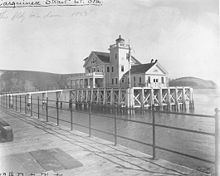Deactivated 1951 (first) Construction wooden tower Automated 1963 Year first constructed 1910 | Foundation wooden pier Opened 15 January 1910 Material Wood | |
 | ||
Location VallejoCaliforniaUnited States Year first lit 1963 (automated beacon and fog signal at the pier) Tower shape square parallelepiped tower with balcony and lantern attached to keeper's house Similar Roe Island Light, Table Bluff Light, Farallon Island Light, Oakland Harbor Light, Cape Mendocino Light | ||
Carquinez Strait Lighthouse is a lighthouse in California, United States. It was originally approximately 20 miles inland from the mouth of the San Francisco Bay near Vallejo, California.
Contents
History
The first lighthouse to mark the entrance to Carquinez Strait and the Napa River, the Mare Island Light was built at the southern end of Mare Island in 1873. The United States Lighthouse Board later realized that a light positioned offshore near the junction of the strait and river would better serve navigation in the area. The lighthouse was deactivated in 1951 and an automated beacon and fog signal were placed on the pier. After years of neglect, which included the smashing of the lens by vandals, the building was saved by investors who moved the residence to the Glen Cove Marina in Vallejo, California.
Historical information from Coast Guard web site
Additional information
Taken from a December 1966 USCG press release:
Carquinez Strait Light Station is an automatic light station located at Vallejo, California between Suisun Bay and San Pablo Bay. It was first placed into operation on January 15, 1910. The original structure, a 28-room light house weighing 150 tons, was used until abandoned by the Coast Guard in 1951. New family quarters were constructed on top of the bluff overlooking San Pablo Bay and the entrances to Carquinez Strait and Mare Island Strait. On August 6, 1955, the original structure was taken off its pilings and put aboard a barge. It was then successfully towed two miles to its new location at Elliott Cove and converted into a resort. The new buildings were constructed in 1951 on top of the bluff The main family dwelling consisted of two 3~bedroom and two 2 bedrooms. The men assigned maintained and operated the light at the end of the breakwater and an automatic fog signal. In addition, the unit was responsible for providing emergency repairs on five aids to navigation in the vicinity of the station. A 24-hour lookout was maintained. On June 3, 1963, the Coast Guard personnel were transferred from the station and the light and fog signal were automated.
